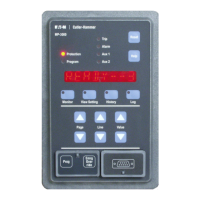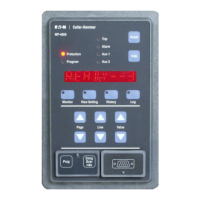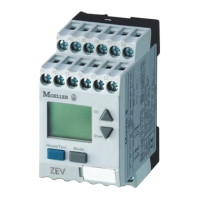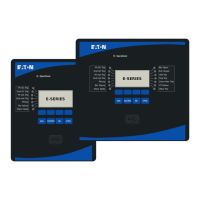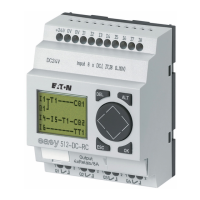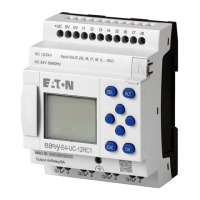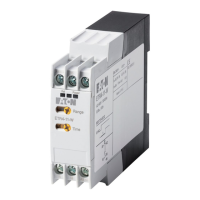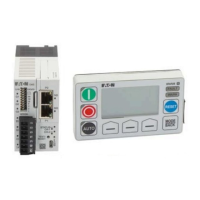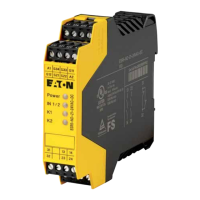For more information visit: www.cutler-hammer.eaton.com
Page 10-1
Effective 10/02 IL17562BH04
SECTION 10—DATA COMMUNICATIONS
10.1 General
Most MP-3000 settings and operating data can be viewed or changed on
the front-panel alphanumeric display. However, with the large volume of
information and settings, many users will find it more convenient to view
or manipulate the data on a host computer with its large graphic display.
The MP-3000 can communicate with Cutler-Hammer PowerNet®,
PowerPort®, and previous-generation IMPACC® distributed control
systems or host software via the communications port and an optional
accessory PONI module mounted on or near the back of the relay.
PowerNet is a high speed, Ethernet based power management system,
that networks state-of-the-art meters, relays, trip units, motor
protectors, starters and transfer switch controllers for efficient energy
management, real-time monitoring, alarming and trending of your
electrical distribution system.
PowerPort is free software that can be downloaded from the Cutler-
Hammer web site at www.cutler-hammer.eaton.com. PowerPort is a
portable, scaled-down version of the flexible and powerful PowerNet
Power Management Software. Whereas PowerNet communicates to
multiple devices over a network, PowerPort communicates to one
device at a time via a direct connection. With PowerPort, you can
configure a single device and view both real time and historical data
from that device. The physical connection between a MP-3000 and a
Personal Computer (PC) can be made by an I-PONI (see Section 10.2)
with either a MINT II or a PMCOM5 to connect the INCOM network to
the serial port of a PC. For details see the technical data sheet
TD.17B.01.T.E at the above web site.
In addition to monitoring and programming, PowerNet and PowerPort
can execute control through communications; including remote
tripping, resetting, and emergency override.
One particular logging function, the starting current profile display,
cannot be viewed on the relay faceplate. The profile data must be
uploaded to a host computer using PowerNet, or PowerPort after the
start. PowerNet and PowerPort provide an informative plot of the
actual starting current curve, plotted along with the cold-start protec-
tion limit curve, for checking of coordination. Profiles are saved for the
last four starts.
Older IMPACC systems do not directly support the MP-3000.
However, the MP-3000 can be set to emulate the communications of
the older Cutler-Hammer or Westinghouse IQ 1000 II motor relay.
Download of settings is not possible in IMPACC.
10.2 Choosing a PONI
The PONI (Product Operated Network Interface) module is inter-
changeable among a number of available styles and provides the
physical and electrical interface to several communications links or
networks. The MP-3000 can work with at least the following PONI
types:
• I-PONI–INCOM Network PONI—the recommended means of
connecting to the robust INCOM communications network.
• B-PONI–Buffered INCOM Network PONI—an older INCOM PONI
type which can only be used for communications in IQ 1000 II
compatible mode. See Section 10.6 below.
• D-PONI–DeviceNet® PONI—a translating PONI for connection to a
DeviceNet control network. Check the firmware version of the D-PONI
for compatibility with an IQ 1000 II or an MP-3000.
• E-PONI–Ethernet PONI with 10BaseT or optical-fiber network
connections—for direct connection to a facility LAN which ties the
MP-3000 to a PowerNet host client computer.
Contact a Cutler-Hammer sales engineer or the Power Management
Products factory for updated information on availability of PONI types.
Each type of PONI has its own instruction leaflet, with information on
mounting and connection.
10.3 Mounting the PONI
Attach the PONI to the back of the MP-3000 using the mounting
bracket supplied with the MP-3000. If the URTD module is to be
mounted on the back of the relay, mount the URTD module with its own
bracket first; then attach the PONI to the back of the URTD module
without the PONI mounting bracket. Section 6, Figure 6.3 shows the
depth of the relay, with or without URTD module, and PONI attached to
the back.
NOTE: Figure 6.3 applies for I-PONI, B-PONI, and D-PONI. The E-
PONI is 0.5 inch deeper than Figure 6.3 shows, as well as being
larger in other dimensions.
10.4 Connecting the PONI to the relay
Each PONI type has a ribbon cable with a 9-pin D-sub connector. This
plugs into the mating 9-pin D connector above the right (rear view)
terminal block of the MP-3000. Secure with captive screws.
The PONI gets its operating power from the MP-3000 through the
ribbon cable.
NOTE: The E-PONI draws more power from the relay than the other
PONI types, and the E-PONI with optical Ethernet communica-
tions demands the most power. This can reduce the ability of
the MP-3000 to ride through prolonged interruptions in the ac
supply. See details in Section 9.3.
If voltage interruption ride-through is important and the E-PONI is used,
power the E-PONI through its external-power connector from a
separate power supply. This unburdens the MP-3000 power supply
and restores full 25 to 50 cycle ride-through capability. See E-PONI
instructions.
NOTE: For the MP-3000 only, PONIs can be “hot-plugged”—
connected or disconnected with the MP-3000 powered. Hot-
plugging may or may not be allowed with various combinations
of other communicating products and PONI types—check
instructions of each device.
10.5 Connecting the PONI to the network or host
Figure 10.1 shows an outline of the I-PONI. The INCOM network
comprises a shielded twisted-pair conductor which is daisy-chained
from one communicating device to the next as shown. There is only
one INCOM network master, which is either a MINT (INCOM network to
RS-232 port converter) or a CONI/CONI III (ISA card for PC with
INCOM port on the rear flange).
INCOM provides full galvanic isolation of every communicating device
from the network, and works reliably in noisy industrial environments.
See IMPACC Systems Communications Manual, I.L 17384. For best
results, follow the network wiring rules in the PONI I.L. and in the
IMPACC wiring specification, T.D. 17513. Proper handling of shield
grounds (don’t ground them everywhere) is important to good noise
immunity.
For INCOM, every communicating device must be set to a unique
